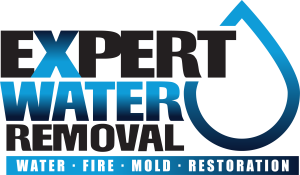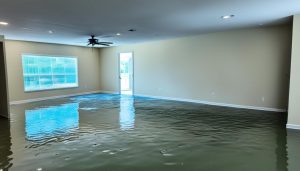Ever thought about how fast water can damage your ceiling after a leak starts? The answer might shock you. We’ll look into the timeline of water damage and how quickly a small leak can turn into a big problem. This includes mold growth and the need for major repairs. Knowing this can help you prevent damage or act fast when problems happen.
Key Takeaways
- Water can start damaging your ceiling within hours to days, depending on the severity of the leak.
- Common sources of ceiling leaks include rainwater, bathroom mishaps, and leaking pipes.
- Quick actions like improving ventilation with fans and using dehumidifiers can mitigate damage.
- Identifying watermarks, bulging ceilings, and mold formation are crucial early signs of water damage.
- Prompt water damage repair is essential to prevent long-term structural issues and health hazards like mold growth.
Introduction to Water Damage on Ceilings
Water damage on ceilings is a common problem for many homeowners. It can lead to big issues if not fixed quickly. Spotting early signs is key to catching water damage early.
This helps homeowners take action fast. It’s important for fixing ceilings and keeping homes in good shape.
Water in ceilings can weaken a building’s structure over time. Problems like mold and swelling materials can occur. Finding water damage early can save money and prevent big repairs.
When water damage is found, acting fast is crucial. Using the right drying methods stops mold and keeps ceilings strong. Finding and fixing the leak is also vital.
Regular checks help prevent ceiling leaks and keep buildings stable. In short, knowing how to handle ceiling water damage saves money and keeps homes safe.
Common Causes of Ceiling Leaks
Ceiling leaks come from many sources. Each one plays a different role in causing water damage. Knowing these sources helps with finding and fixing leaks.
Rainwater Leaks
Rainwater leaks are common, especially when roofs are damaged. If a roof is not in good shape, rain can get in. This can cause a lot of damage to the ceiling. It’s important to fix roof damage quickly to avoid more problems.
Bathroom Leaks
Bathroom leaks often happen when bathtubs, showers, or sinks overflow. These leaks can cause a lot of water damage if not caught early. Using the right tools to find leaks helps prevent damage to ceilings and other areas.
Leaking Pipes
Leaks in pipes inside walls or ceilings are another common problem. Pipes can wear out over time due to age or corrosion. Plumbers use special tools to find and fix these leaks, helping to protect your property.
Signs of Ceiling Water Damage
It’s important to know the signs of ceiling water damage to protect your home. Here are some clear indicators that your ceiling might be damaged by water.
Watermarks and Stains
Watermarks and stains are common signs. They show up as colored patches on ceilings or walls. Spotting these early can help find and fix the leak before it gets worse.
Bulging or Swelling Ceilings
Bulging ceilings are a clear sign of water damage. Moisture makes the ceiling material swell and change shape. It’s crucial to act fast to avoid the ceiling collapsing.
Mold Formation
Mold is a sign of water damage and a health risk. It can grow in just 48 hours in damp places. Fixing the moisture problem is key to stop mold and health issues.
Moisture Condensation
Moisture condensation looks like “sweating” on walls and ceilings. It’s a small but important sign of water damage. If not fixed, it can lead to mold and more problems.
How Long Does It Take for Water to Damage a Ceiling?
Water damage can harm a ceiling’s structure quickly. The time it takes depends on how much water, the ceiling’s material, and its initial state. Knowing how water damage unfolds is key to preventing ceiling collapse.
Several factors affect how fast a ceiling gets damaged:
- Amount of Water: More water means faster and worse damage.
- Material Type: Materials like plaster and drywall soak up water quickly, leading to faster damage.
- Initial Condition: Older or already damaged ceilings are more vulnerable to water damage.
Act fast if you spot a leak to keep your home safe. Take steps to reduce damage and strengthen weak spots. Ignoring leaks can lead to serious damage, putting your home and family at risk.
Steps to Take When You Notice Water Damage
When you see water damage on your ceiling, act fast to protect your property. Follow these steps to handle the situation well.
Identify the Source of the Leak
First, find out where the water is coming from. This is key to fixing the problem right. Look at the attic, roof, and plumbing for leaks.
Contain the Leak
After finding the leak, manage it. Turn off the water if you can and use buckets to catch the water. If the leak is bad, use strong materials to stop it until help arrives.
Repair the Source of the Leak
Fixing the leak’s cause is crucial. This might mean fixing a roof or pipes. Quick action or calling a pro is needed to stop more damage.
By taking these steps, you can deal with water damage better. This helps keep your property safe and your home a good place to live.
How to Dry Your Ceiling Fast
Acting quickly is key when your ceiling gets water damage. Start by removing water with a wet-dry vacuum. This makes the area dry enough for the next steps.
Next, use dehumidifiers to get rid of extra moisture in the air. They help dry your ceiling faster. Place dehumidifiers in the wet area and set them to the highest setting.
To dry your ceiling even faster, use fans and open windows. Fans blow air over the wet ceiling. Opening windows and doors helps air move, speeding up drying.
If a lot of water has damaged your ceiling, get professional help. Experts have special tools and methods for big water damage. They also check for mold and damage.
Usually, ceilings dry in 48 hours. But after painting or plastering, it takes 24 more hours. Waiting this long ensures your ceiling is dry and safe.
By following these steps, you can handle water-damaged ceilings well. Use quick drying methods and dehumidifiers to keep your home safe.
Conclusion
Acting fast is key when dealing with ceiling water damage. Even small delays can lead to big problems. Spotting signs like watermarks, bulging ceilings, and mold early helps fix issues quickly.
Fixing the leak source and drying the area well can stop more damage. This is crucial to avoid bigger problems.
After water hits the ceiling, it usually takes 48 hours to dry. But, if the damage is severe, getting help from experts is a must. They ensure the damage is fully fixed and prevent long-term damage.
Companies like Expert Water Removal are key in fixing water damage. They offer top-notch services to keep ceilings safe and properties valuable. Their quick help means faster repairs and peace of mind for property owners.
Contact Expert Water Removal today for emergency, professional water damage restoration services.








